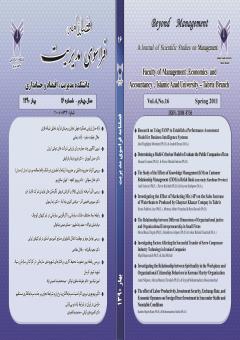Determining a Multi -Criterion Model to Evaluate the Public Companies of Iran
Subject Areas : Business ManagementHasan Givarian 1 , Firooz Dindar Farkoos 2
1 - Faculty Member of Management Department, Tehran Branch, Islamic Azad University, Tehran, Iran
2 - Faculty Member of Management Department, Tehran University Branch, Islamic Azad University, Tehran, Iran
Keywords: Evaluation, Performance, Organizational Performance, Leadership,
Abstract :
Organizational performance is one of the controversial and important issues which has always preoccupied the managers of different sectors. Different views have been presented on the evaluation of organizational performance and the related variables studied in this regard. Several models and dimensions have been identified within the past decades and have sometimes been executed in different organizations. The aim of this paper is to determine a local and multi-criterion model for the evaluation of the public organizations. Therefore, after reviewing the literature, the factors to be studied were categorized as the intra- and extra - organizational dimensions, and with the use of statistical techniques such as one-factor variance analysis and Tookibi test, they were analyzed within the statistical population of 170 people. The results showed that in the intra-organizational dimension, the most important factor affecting the organizational performance is the role of leadership and in the extra-organizational dimension; the most effective factor is programming and applying social-Islamic values in Iran.
Abbot, M., & Doucouliagos, C.(2003),The efficiency af Australian University:a data envelopment analysis.Economics of Education Review,22(1).
Abyli, Kh. (2001). Knowledge Management. Moderator Flushman, 8, (In Persian).
Anvari Rostami, A. A. (1999). Investigating Effective Models in Evaluating the performance of Executive Agencies of the Country, (In Persian).
Bobe, B.(2009),Evaluating the efficiencies of university faculities:Adjusted data envelopment analysis.Paper for Accountaing and Finance Association of Australia and new Zealand Conference.Adelaide.
Carter Mcnamara. (1990), «organizational systems checklist for non profit organization».
Chang, G. (2000). Introducing 360 Degree Method Approach to Service Performance Evaluation, (In Persian).
Delahaye Kahtarine & H.bender Dennis (2001), «Anon-profit bulds a ».
Elahi, Sh. (1999). Organizational Performance Triangle. The Performance of Executive Organizations of the Country, (In Persian).
Ghasemi, A. R. (2000). The Scope of Social Responsibility of Managers. Tadbir, 89, (In Persian).
Howard, R. (2003), Abalacing Act, perform, V.2.
Iran Nezhad Parizi, M. (1998). Ethical and Social Responsibilities of Management. Management Knowledge, 18, (In Persian).
Kao, C, & Hung, T. (2008), Efficiency analysis of university departments: An empirical study.omega, 36(4).
Saleh Oliya, M. (1999). Evaluation of the Performance of Executive Bodies of the Country. The Conference on the Evaluation of the Performance of Executive Agencies of the country, (In Persian).
Tabarsa, Gh. (1999). A Study and Review the Role of Strategic Requirements in the Selection of a Model for the Evaluation of the Performance of Government Organizations. The Conference on the Evaluation of the Performance of Executive Organizations of the Country, (In Persian).
Zheng, W. (2005), The impact of organizational culture, structur, and strategy on-knowledge management effectiveness and organizational effectiveness, University of Minnesota.
_||_Abbot, M., & Doucouliagos, C.(2003),The efficiency af Australian University:a data envelopment analysis.Economics of Education Review,22(1).
Abyli, Kh. (2001). Knowledge Management. Moderator Flushman, 8, (In Persian).
Anvari Rostami, A. A. (1999). Investigating Effective Models in Evaluating the performance of Executive Agencies of the Country, (In Persian).
Bobe, B.(2009),Evaluating the efficiencies of university faculities:Adjusted data envelopment analysis.Paper for Accountaing and Finance Association of Australia and new Zealand Conference.Adelaide.
Carter Mcnamara. (1990), «organizational systems checklist for non profit organization».
Chang, G. (2000). Introducing 360 Degree Method Approach to Service Performance Evaluation, (In Persian).
Delahaye Kahtarine & H.bender Dennis (2001), «Anon-profit bulds a ».
Elahi, Sh. (1999). Organizational Performance Triangle. The Performance of Executive Organizations of the Country, (In Persian).
Ghasemi, A. R. (2000). The Scope of Social Responsibility of Managers. Tadbir, 89, (In Persian).
Howard, R. (2003), Abalacing Act, perform, V.2.
Iran Nezhad Parizi, M. (1998). Ethical and Social Responsibilities of Management. Management Knowledge, 18, (In Persian).
Kao, C, & Hung, T. (2008), Efficiency analysis of university departments: An empirical study.omega, 36(4).
Saleh Oliya, M. (1999). Evaluation of the Performance of Executive Bodies of the Country. The Conference on the Evaluation of the Performance of Executive Agencies of the country, (In Persian).
Tabarsa, Gh. (1999). A Study and Review the Role of Strategic Requirements in the Selection of a Model for the Evaluation of the Performance of Government Organizations. The Conference on the Evaluation of the Performance of Executive Organizations of the Country, (In Persian).
Zheng, W. (2005), The impact of organizational culture, structur, and strategy on-knowledge management effectiveness and organizational effectiveness, University of Minnesota.


